If you’re looking for the best ham radio base station antenna, there are a few factors you should consider before making your purchase. The right antenna can greatly enhance your communication capabilities, whether it’s for personal or professional use. First, consider the radio frequency range you will need. The antenna’s length and design will greatly impact this. Additionally, consider the durability and construction of the antenna. Will it be able to withstand harsh weather conditions? The size and weight of the antenna should also be taken into account, as it will impact how and where it can be mounted.
One important factor to keep in mind when purchasing a ham radio base station antenna is the level of support and documentation available from the manufacturer. This can greatly impact how successful you are in setting up and using the antenna. Another important consideration is your budget. There are many great options on the market, so it’s important to be clear on what you're willing to spend before making your final decision. Keep in mind that a quality antenna is an investment that will last for years if properly maintained.
Are you tired of your radio signal being constantly disrupted? Do you want to improve your communication capabilities with friends or colleagues? If so, investing in the best ham radio base station antenna could be the solution you need. But with so many options on the market, it can be tough to know where to start. What size and design should you choose? Which brands are most reliable? Keep reading to learn more about how to select the right base station antenna to suit your specific needs.
10 Best Ham Radio Base Station Antenna
| # | Product Image | Product Name | Product Notes | Check Price |
|---|---|---|---|---|
|
1
|
It is ideal for use as a heavy-duty fiberglass vertical base antenna that operates on dual bands.
|
|
||
|
2
|
Ideal for improving signal quality and transmission for CB and 10 meter radio communication with a maximum of 1000 watts.
|
|
||
|
3
|
The product is ideal for scanning various frequency ranges including VHF/UHF and CB transmit bands.
|
|
||
|
4
|
This product is ideal for providing a ground plane kit for base or field use with an SO-239 connector and mounts to a 2" pole, mast, or pipe.
|
|
||
|
5
|
The product is ideal for use as a base station vertical antenna for CB or ham radios.
|
|
||
|
6
|
Ideal for amateur radio enthusiasts looking for a dual-band base antenna for VHF and UHF frequencies.
|
|
||
|
7
|
The product is ideal for CB radio communication and it can be used as a base station antenna.
|
|
||
|
8
|
This product is ideal for amateur radio enthusiasts looking for a dual-band VHF/UHF base antenna.
|
|
||
|
9
|
It is an ideal product for those who need a compact and portable antenna to use in various locations.
|
|
||
|
10
|
This product is ideal for amateur ham radio enthusiasts who need a vertical base antenna with multiple band capabilities.
|
|
1. Comet Dual Band Heavy-Duty Fiberglass Antenna
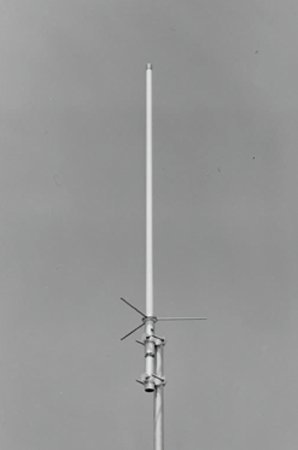
The Dual Band Base Vertical 146/446MHz is an exceptional choice for those in need of reliable communication. This antenna boasts impressive specifications, including a Gain of 146MHz 3.0dBi and 446MHz 6.0dBi, ensuring clear and uninterrupted communication. It has a VSWR of 1.5:1 or less and can handle a maximum power of 200 watts SSB/100W FM.
With a length of 4’2” and a weight of 2 lbs, this antenna is easy to install and move around as needed. The SO-239 connector provides excellent connectivity, and the heavy-duty fiberglass construction ensures durability and longevity.
Whether you're a professional in need of constant communication or an amateur radio enthusiast, the Dual Band Base Vertical 146/446MHz is an ideal choice for your communication needs. Its impressive specifications, ease of installation, and durability make it an excellent investment that exceeds expectations.
2. New Starduster M400 Base Station Cb Ham 10 Meter Antenna M-400 18' 1000 Watt 7db
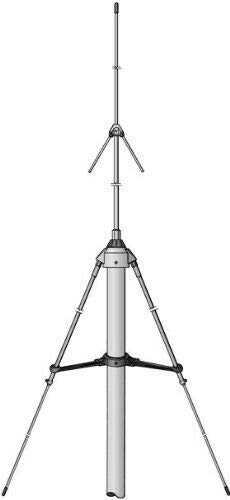
Looking for a top-quality base station antenna for your radio system? Look no further than this expertly crafted model, designed to offer exceptional performance and durability.
Crafted from high-quality anti-corodal aluminum tube, this base station antenna is built to last, providing reliable service for years to come. And with its impressive range of tunability, from 26.5 to 30 MHz, it's the perfect choice for a wide range of applications.
Whether you're a professional operator or a hobbyist, this base station antenna is sure to impress. It's compatible with a variety of top brands, including Cobra, Uniden, Galaxy, Ranger, Midland, Stryker, Magnum, Connex, General Lee, President, and Mirage, ensuring that it will work seamlessly with your existing system.
So why wait? Whether you're looking to upgrade your radio system or simply want to enjoy better performance and range, this base station antenna is the perfect choice. With its superior construction, impressive tunability, and broad compatibility, it's sure to exceed your expectations.
3. Tram 1411 Scanner 25mhz–1,300mhz Vhf/uhf Super Discone Base Antenna Plus Cb Transmit Bands, Silver
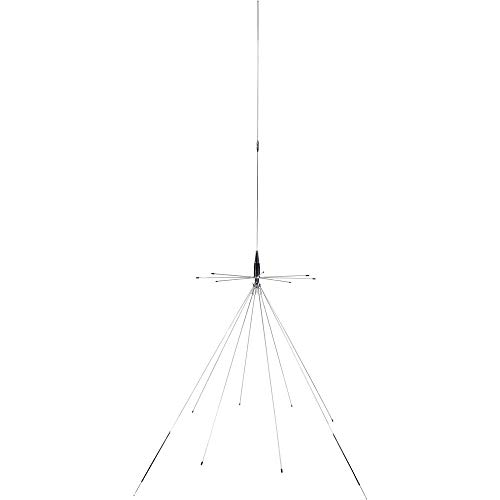
The Wideband Reception Antenna is a versatile and reliable option for those seeking maximum power and rust-free durability. This antenna covers a wide range, from 25 to 1300 MHz, ensuring a broad spectrum of reception capabilities. The antenna is constructed with high-quality stainless steel, which guarantees long-lasting protection against rust and other environmental factors that may otherwise degrade its performance.
With a maximum power of 300 Watts for CB and 200 Watts for VHF-UHF, this antenna proves to be a powerful tool for communication. Its SWR rating is less than 1.5:1, ensuring a smooth and efficient signal transfer. The antenna can fit a maximum mast diameter of 1 3/8 inches and comes with a UHF female (SO-239) connector, making it easy to install and connect to other devices.
The Wideband Reception Antenna also features six lower radials measuring 32 3/4 inches, two lower radials that are adjustable from 48 to 52 inches, and eight upper radials measuring 11 1/4 inches. These radials are designed to provide additional support and stability to the antenna, ensuring that it remains steady and maintains optimal performance. The top whip length of the antenna measures 55 inches, providing a strong and reliable signal.
4. Nagoya's 21" Radial Ground Plane Kit
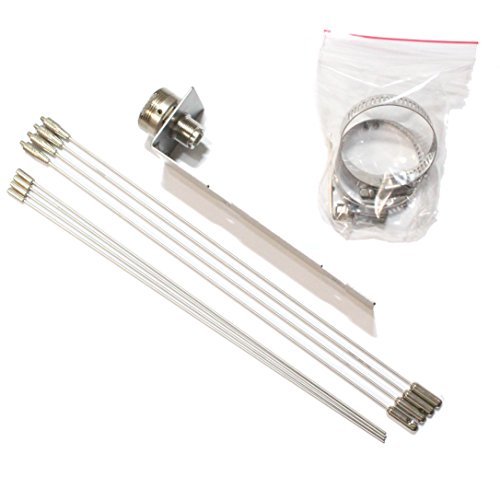
The Certified Original Nagoya Antenna Mount is a top-of-the-line mounting solution for antennas, made possible through an exclusive manufacturing partnership with BTECH. This set includes a base NMO/UHF bracket, mounting clamps, four ground radials (in two sections), and a mounting bracket.
To connect the mount to a radio, it requires a coaxial cable with an SO-239 connector. For optimal use with BTECH mobile radios, a 50 ohm low loss coax with PL-259 terminations on both ends is recommended. This will allow for easy deployment in the field or at home, providing a reliable connection to your radio.
The Nagoya Antenna Mount is designed to withstand extreme weather conditions, with a wind load rating of up to 100 MPH (48 m/sec). It is also compatible with a wide range of UHF, HF, and VHF NMO antennas, covering a frequency range of 0 – 520MHz.
Whether you're a professional or amateur radio operator, the Nagoya Antenna Mount is an excellent choice for a sturdy, reliable, and high-performing antenna mounting solution. With its top-quality manufacturing and compatibility with a wide range of antennas, you can be sure that this mount will provide you with the perfect platform for your radio communication needs.
5. Solarcon – Imax-2000 Cb/ham Radio Base Station Vertical Antenna, 24-Feet
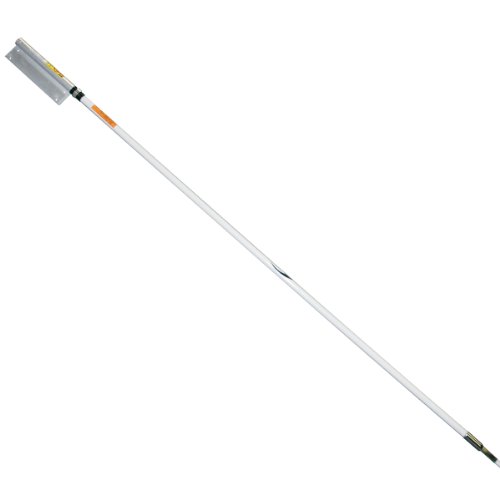
The MAX-2000 (formerly known as IMAX-2000) is a full 5/8 wave antenna, designed to provide exceptional CB radio performance. This updated version of the product features new packaging, but the same reliable and high-quality performance that customers have come to expect.
The MAX-2000 is comprised of three easy-to-assemble sections, each measuring 8 feet in length. Once assembled, the antenna stands at an impressive 24 feet tall, providing optimal signal reception. The 5.1dBI gain further enhances the antenna's performance, ensuring clear and consistent communication.
One of the key features of the MAX-2000 is its broad bandwidth. Unlike traditional CB antennas, this product covers a wide range of frequencies, both above and below the standard CB channels. This ensures that users can communicate effectively over a range of frequencies, making it an ideal choice for those who frequently travel or operate in remote areas.
The MAX-2000 also comes equipped with SWR tuning, allowing users to fine-tune the antenna for optimal performance. This feature ensures that the antenna is operating at maximum efficiency, providing the best possible signal quality.
6. Dual-Band Fiberglass Antenna For Amateur Radio
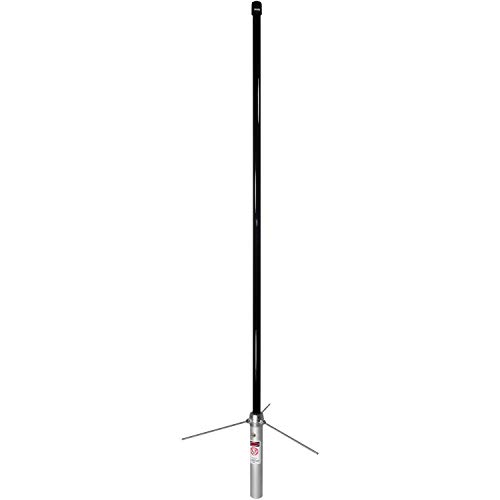
Introducing a sleek and efficient antenna that is pre-tuned and ready to use right out of the box! No need to fiddle with any settings or tuning adjustments, this antenna is designed to provide maximum performance with minimal effort. Standing at a height of 43 inches, this single section antenna is perfect for those who value simplicity and convenience.
When it comes to signal strength, this antenna truly shines. With an impressive 3.5dBd actual gain for VHF and 6dBd actual gain for UHF, users can enjoy crystal-clear reception without any interference. This means that you can enjoy all of your favorite shows and channels without any frustrating lag or signal drops.
So whether you're a casual television watcher or a serious media enthusiast, this pre-tuned antenna is the perfect choice for anyone looking for a hassle-free and high-performing solution. With its impressive specifications and easy-to-use design, this antenna is sure to impress even the most discerning of users.
7. Solarcon A-99 Cb Base Station Antenna
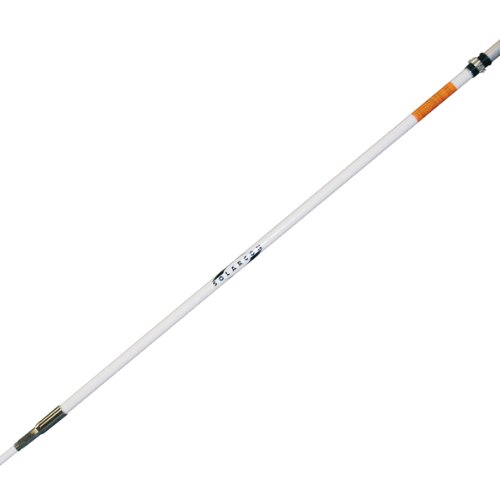
The SOLARCON A-99 17.5' Omni-Directional Fiberglass Base Station CB Antenna is a high-quality product that boasts a range of impressive features. With the ability to handle 200 Watts PEP, this antenna is capable of providing reliable performance that will keep you connected at all times.
Not only is this antenna perfect for CB use, but it can also be used for 10M-12M Amateur use, making it an incredibly versatile option. However, it's important to note that an optional mounting mast and coaxial cable are required for optimal performance.
One of the standout features of this antenna is its tunability. It can be easily tuned for the lowest SWR reading, ensuring that you get the best possible performance every time you use it. This makes it an ideal choice for those who demand the highest levels of quality and reliability from their equipment.
8. Ultimate Dual-Band Base Antenna!
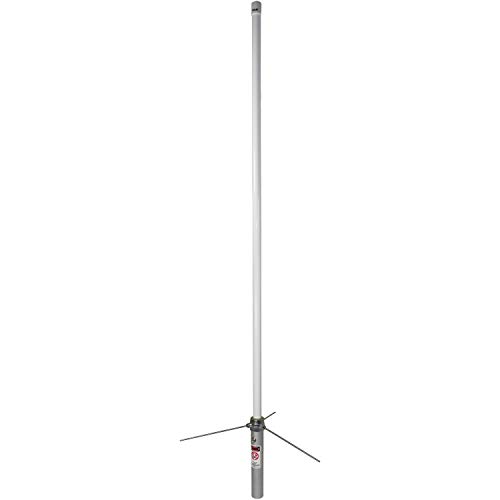
The product being reviewed is a pre-tuned antenna that requires no additional tuning. This antenna stands at a height of 43 inches, making it a great option for those looking for a moderately sized antenna. It is a single-section antenna that provides 3.5dBd actual gain VHF and 6dBd actual gain UHF.
One of the standout features of this antenna is that it comes pre-tuned, meaning that no additional tuning is required before installation. This makes it an excellent option for those who are new to antenna installation or who may not have the necessary equipment to tune an antenna themselves.
Additionally, the antenna stands at a height of 43 inches, making it a great option for those who are looking for a moderately sized antenna. This size is ideal for those who live in areas with moderate to strong signal strength.
The antenna is a single-section design, which helps to simplify the installation process. This design also helps to reduce the overall weight of the antenna, making it easier to handle during installation.
In terms of performance, the antenna provides 3.5dBd actual gain VHF and 6dBd actual gain UHF. This means that it is capable of receiving both VHF and UHF signals and provides a moderate amount of gain. This makes it a good option for those who live in areas where the signal strength is moderate to strong.
9. Workman Saturn B100 Base Station Apartment Attic Patio Balcony Boat Truck Antenna
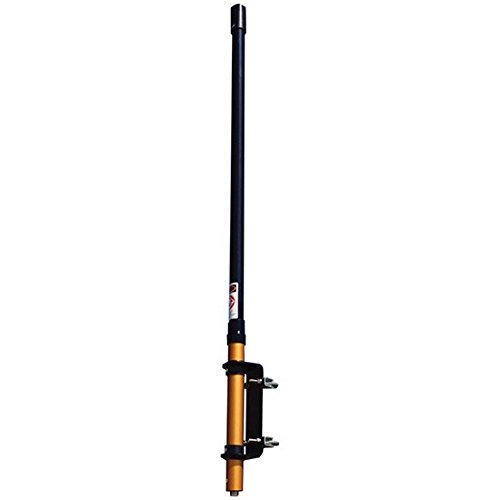
Introducing the Compact CB Radio Antenna, the perfect solution for those looking for a high-quality CB radio antenna with a no groundplane requirement. This versatile antenna can be used on a variety of surfaces such as fiberglass, wood, metal, or other types of surfaces without the need for a groundplane. This makes it a great option for those with limited space or who are looking for a portable CB radio antenna.
The Compact CB Radio Antenna covers all 40 channels, ensuring that you can communicate with other CB radio users with ease. Whether you are on the road or at home, this antenna is designed to provide clear and reliable communication.
To use this antenna, you will need 18ft or more length of optional coaxial cable with a regular PL-259 connector. This will ensure that you can easily connect your CB radio to the antenna and start communicating right away. The Compact CB Radio Antenna is easy to install and can be set up in minutes, so you can start using it right away.
10. Hustler Hf Multiband Vertical Amateur Ham Radio Base Antenna 5btv

The HF Ham Radio Vertical MultiBand High Performance Base Antenna is a versatile and efficient piece of equipment for transmitting and receiving signals across a wide range of frequencies. With coverage for the 10-80M bands (10, 15, 20, 40, 75/80 meters), this antenna is capable of handling up to 1500W PEP and stands at approximately 25ft tall with aluminum coils.
Designed to be ground or roof mounted, this antenna can attach to most standard optional mast pipes. It requires an optional length of 50 ohm coax cable to connect to your radio. The HF Ham Radio Vertical MultiBand High Performance Base Antenna is compatible with AM, SSB, FM, and CW modes.
Whether you're an experienced ham radio operator or just getting started, this antenna is an excellent choice for its high performance and flexibility. With its multi-band coverage and durable construction, you can rely on it for clear and reliable communication.
Investing in the HF Ham Radio Vertical MultiBand High Performance Base Antenna is a smart choice for anyone looking to enhance their ham radio setup. Its impressive parameters and specifications make it an ideal option for those who prioritize quality and performance.
Best Ham Radio Base Station Antenna FAQs
Can a ham radio base station antenna be used for both transmitting and receiving?
Yes, a ham radio base station antenna can be used for both transmitting and receiving signals. In fact, most ham radio antennas are designed to be used for both purposes. The antenna's ability to transmit and receive signals is determined by its design and the frequency range it covers.
Ham radio antennas come in different types and sizes, including vertical, horizontal, and directional antennas. Each type has its own advantages and disadvantages, depending on the user's needs and the conditions of the radio environment.
It is important to note that a good quality antenna is crucial for effective communication in ham radio. A well-designed and installed antenna can significantly improve the transmission and reception of signals, which can enhance the overall performance of a ham radio station.
Overall, ham radio base station antennas are designed to be versatile and capable of both transmitting and receiving signals. It is important to choose the right type of antenna for the desired frequency range and to ensure that it is properly installed and maintained to achieve optimal performance.
How do I choose the right coaxial cable for my ham radio base station antenna?
When it comes to choosing the right coaxial cable for your ham radio base station antenna, there are a few factors to consider. The first thing to look at is the frequency range of your antenna. Different coaxial cables have different frequency ranges, so you'll want to make sure you choose a cable that is appropriate for the frequencies your antenna will be transmitting and receiving on.
Another important factor to consider is the length of the cable. Longer cables can lead to signal loss, so it's important to choose a cable that is as short as possible while still allowing you to connect your antenna to your radio.
You'll also want to look at the type of connector on the cable and make sure it is compatible with both your antenna and your radio. Common connector types for coaxial cables include PL-259, N-type, and BNC.
Finally, you'll want to consider the quality of the cable itself. Look for cables with low loss and high shielding to minimize interference and signal degradation.
By considering these factors, you can choose the right coaxial cable for your ham radio base station antenna and ensure reliable communication.
How do I ensure my ham radio base station antenna is properly grounded?
Proper grounding of your ham radio base station antenna is crucial for safety and optimal performance. Here are some steps you can take to ensure your antenna is properly grounded:
1. Find a suitable location for the antenna: Look for a spot that is away from power lines, trees, and other structures. The antenna should be at least 10 feet away from any power lines.
2. Install a ground rod: A ground rod is a long metal rod that is driven into the ground. It provides a low-resistance path to ground. The rod should be at least 8 feet long and made of copper or galvanized steel. It should be installed at least 6 feet away from the base of the antenna.
3. Attach a ground wire: A ground wire should be attached to the ground rod using a ground clamp. The wire should be at least 10 gauge and made of copper. It should be run from the ground rod to the base of the antenna.
4. Connect the ground wire to the antenna: The ground wire should be attached to the base of the antenna using a ground lug. The lug should be securely fastened to the antenna.
5. Test the ground: Use a multimeter to test the resistance between the ground wire and the ground rod. The reading should be as close to zero as possible.
By following these steps, you can ensure that your ham radio base station antenna is properly grounded and ready for safe and effective use.
How do I install and tune my ham radio base station antenna for optimal performance?
Installing and tuning your ham radio base station antenna for optimal performance requires some basic knowledge and skills. Here are some steps to follow:
1. Choose the right location for your antenna. It should be at least 10 feet away from any power lines, buildings, or other antennas. It should also be high enough to avoid obstacles and interference.
2. Install the antenna according to the manufacturer's instructions. Make sure it is securely attached to the mast or tower.
3. Connect the coaxial cable from the antenna to the radio. Use a high-quality cable with low loss to minimize signal loss.
4. Tune the antenna by adjusting its length and position. Use an SWR meter to measure the standing wave ratio and adjust the antenna until the SWR is below 1.5:1.
5. Test the antenna by contacting other ham radio operators. Monitor the signal strength and clarity to ensure optimal performance.
Remember to always follow safety guidelines when installing and tuning your ham radio base station antenna. Consult with experienced ham radio operators or seek professional assistance if you are unsure about any aspect of the process.
How does the length of the antenna affect its performance on a ham radio base station?
The length of the antenna on a ham radio base station is a crucial factor that can significantly affect its performance. In general, the length of the antenna determines its resonant frequency, which is the frequency at which the antenna is most efficient at transmitting and receiving signals.
A longer antenna can provide better reception and transmission of signals at lower frequencies, while a shorter antenna can perform better at higher frequencies. This is because the length of the antenna is directly proportional to the wavelength of the signal it can receive and transmit.
However, it is essential to note that the length of the antenna alone is not the only factor that affects its performance. The type of antenna, its location, the terrain, weather conditions, and electromagnetic interference can also affect its performance.
In conclusion, the length of the antenna is an important consideration when choosing an antenna for a ham radio base station. Still, it is crucial to consider other factors that can affect its performance and select an antenna that best fits the specific needs and requirements of the user.
What are the features I should look for in a ham radio base station antenna?
When looking for a ham radio base station antenna, there are several features to consider. First, you want to make sure that the antenna is designed for the frequency range you will be operating on. Additionally, the antenna should have a high gain and a low takeoff angle to ensure maximum signal strength and distance. The antenna should also have a durable construction to withstand harsh weather conditions.
Another important feature to consider is the antenna's radiation pattern. Depending on your operating needs, you may want an antenna with a directional or omnidirectional radiation pattern. A directional antenna will focus the signal in one direction, while an omnidirectional antenna will broadcast the signal in all directions.
Finally, you should also consider the installation process and the size of the antenna. Make sure the antenna is easy to install and won't take up too much space. Overall, choosing the right antenna for your ham radio base station is crucial for optimal performance and communication capabilities.
What is the best type of antenna for a ham radio base station?
The best type of antenna for a ham radio base station is largely dependent on a few key factors, such as the frequency range you plan to operate on, your location, and your budget. Some popular options include dipole antennas, Yagi antennas, and vertical antennas.
Dipole antennas are relatively inexpensive and easy to construct, making them a popular choice for many ham radio operators. They work well for both short and long-range communications, and are particularly effective for frequencies below 30 MHz.
Yagi antennas are directional antennas that offer higher gain and better range than dipole antennas. They are ideal for long-range communications, such as communicating with satellites or other stations at a distance.
Vertical antennas are another popular option, particularly for frequencies above 30 MHz. They are easy to install and require less horizontal space than dipole or Yagi antennas.
Ultimately, the best type of antenna for your ham radio base station will depend on your specific needs and circumstances. It is important to do your research and consult with experts in the field to ensure you are making the best choice for your situation.
What is the difference between a vertical and horizontal ham radio base station antenna?
A vertical and a horizontal ham radio base station antenna differ in their radiation patterns and the direction of their signals. A vertical antenna radiates signals in all directions, making it ideal for communication with other stations at different locations and elevations. The radiation pattern of a vertical antenna is omnidirectional, which means it covers 360 degrees horizontally but has a low angle of radiation. This makes it well-suited for long-distance communication.
On the other hand, a horizontal antenna has a directional radiation pattern that focuses signals in a particular direction. It is ideal for communication with stations located in a specific direction and elevation. A horizontal antenna is characterized by a higher angle of radiation, which makes it suitable for communication with nearby stations.
In summary, the choice between a vertical and a horizontal ham radio base station antenna depends on a user's communication needs. If a user wants to communicate with stations located in different directions and elevations, a vertical antenna is the best option. However, if a user wants to communicate with stations located in a specific direction and elevation, a horizontal antenna is more suitable.
What is the ideal height for a ham radio base station antenna?
The ideal height for a ham radio base station antenna depends on various factors, including the frequency of operation and the type of antenna used. Generally, higher is better when it comes to antennas as it helps to increase the line of sight between the transmitter and receiver. However, this does not mean that the antenna should be placed too high, as this may result in an increased risk of lightning strikes and may also cause stability issues.
For VHF and UHF frequencies, a height of 20 to 30 feet above the ground is generally sufficient for good performance. However, for HF frequencies, a height of at least 40 feet or more may be required to achieve optimal performance. It is also important to ensure that the antenna is properly grounded and that all safety precautions are taken when installing and maintaining the antenna.
Ultimately, the ideal height for a ham radio base station antenna will depend on a range of factors, and it is best to consult with an experienced ham radio operator or antenna specialist for guidance on the best height for your specific setup.
What is the maximum power handling capability of a ham radio base station antenna?
The maximum power handling capability of a ham radio base station antenna can vary depending on the specific model and manufacturer. Generally, most base station antennas can handle a maximum power output of 1,500 watts or more. However, it is important to note that simply having a high power handling capability does not necessarily mean that the antenna will perform better than a lower-rated one. Other factors such as the antenna's gain, radiation pattern, and frequency response also play a crucial role in determining its overall performance. Therefore, it is important to carefully evaluate all of these factors before selecting an antenna for your ham radio base station. Additionally, it is recommended to consult with a knowledgeable expert to ensure that you select the best antenna for your specific needs and requirements.
